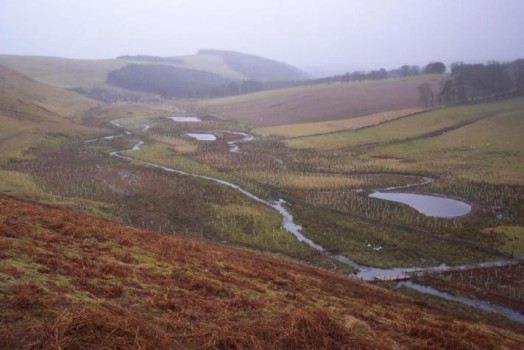Supporting guidance for Management of Floodplains
Date published: 13 January, 2023
For recent changes to this guidance, please see the bottom of the page.
Updates to last version:
- removal of details under How can you add value on other management options
Introduction

A river floodplain is area where a watercourse floods naturally at times of high water level. The river sediment deposited on a floodplain following each flood event creates a mixture of drylands and wetlands, which support a rich and diverse range of habitats and species. In their natural state, floodplains store and slow the flow of flood waters, helping to reduce flooding further downstream. They can also reduce the extent of sediment deposition on the river bed and prevent bank erosion by reducing the energy of the water within the river channel.
The purpose of this option is to manage livestock on newly restored floodplains where embankments have been removed or abandoned to benefit flood risk and biodiversity. It can be particularly useful where flooding downstream is a problem and the floodplain area available to store water is large.
This item will fund the removal of stock from the floodplain during times of flooding.
What needs to be done?
The floodplain should be allowed to flood, at least in part, and stock removed during times of flooding. This will mean abandoning or removing an embankment. A diary should be kept detailing all livestock movements.
Newly restored floodplains can be entered into management and management of floodplains restored under previous AECS agri-environment application rounds can be continued in a subsequent application.
Note that the floodplain should only be allowed to flood if doing so does not increase flooding to properties or infrastructure (roads, etc), upstream, downstream or on the other side of the watercourse.
Where the floodplain extends into a parcel of land owned by a neighbouring land manager / owner, you should seek agreement to apply for this option from that party. In such instances, you should consider seeking the help of a facilitator. Some facilitation fees can be paid for by the co-operative action fund.
How can you add value
Where you propose to allow the floodplain to flood through embankment removal, lowering or breaching, you should consider applying for additional capital payments to undertake this work.
Further information
Guidance documents
- EU Healthy Catchments Manual
- River Restoration Centre – Manual of River Restoration Techniques
- The Scottish Rivers Handbook: A Guide to the Physical Character of Scotland’s Rivers, Perfect, C., Addy, S. and Gilvear, D. (2013)
Case studies
Recent changes
| Section | Change |
|---|---|
| What needs to be done | Added para indicating newly restored floodplains can be entered into management and management of floodplains restored under previous AECS agri-environment application rounds can be continued in a subsequent application. |
